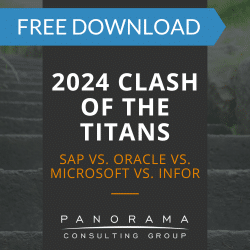ERP projects can be lengthy. Depending on the scope of the project, implementation can last anywhere from six months to three years. After implementation, ERP software should support an organization for at least five to ten years. As you can imagine, choosing an ERP solution to scale with your business is an important consideration when selecting an ERP system.
Software scalability refers to a system’s ability to keep pace with your business’s trajectory. This means that an ERP solution should be able to take on new markets and handle exponential increases in transactional volume, workload and amount of data.
SAP vs. Oracle Case Study
SAP and Oracle both invest heavily in cloud technology. However, our client was skeptical about cloud scalability and unsure if the products were mature and proven.
When looking for a scalable ERP solution, we recommend asking ERP vendors about factors, such as global functionality, infrastructure options and integration capabilities. Most importantly, ask them how they address the latest technology trends, and how they can adapt to your future business needs.
In addition to asking questions of vendors, you should also investigate several questions on your own:
4 Scalability Questions
1. Does the ERP System Have Global Capabilities?
One way that many businesses expand is through globalization. If your company currently is in the US market but plans to expand to the rest of North America and eventually to Europe and Asia, you may want to consider an ERP system that offers a global solution out-of-the-box. Here are some considerations:
Taxes and Regulations
There are some countries for which many ERP systems have difficulty complying with their tax rules and government regulations.
For example, Brazil has one of the most complex tax systems in the world, and oftentimes ERP consultants will need to specialize in – or at a minimum – have experience with Brazilian implementations to be successful. Knowing this challenge, some ERP vendors have come up with “localizations” specific to countries to help companies doing business in other countries stay compliant.
Another example is the data localization laws in Russia. The laws require that data relating to Russian customers must reside on servers within the country. This poses a challenge for companies beginning a new ERP implementation or expanding an existing ERP system.
Other countries, like China, are adopting similar data localization laws, forcing many ERP vendors to build localizations for their customers.
Languages
If your business wants to compete in the global marketplace, it must advertise and transact in a multitude of different languages.
For example, vendor-facing documents, like requests for proposal (RFPs) or purchase orders, must be in the local language. Customizing reports for different languages can be costly and time consuming.
The same thing can be said for customer-facing documents, like sales orders and invoices. If your business maintains an e-commerce presence, this adds another layer of complexity regarding languages and translations.
Many ERP vendors today provide out-of-the-box language translations to support global customers. When assessing if an ERP system is the right fit for your business, make sure to ask about language options to prevent an unwelcome surprise when you scale your company in the future.
2. Does the ERP System Have a Scalable Infrastructure?
As your business grows, you want your ERP system infrastructure to be able to grow with you. This may look different depending on your IT infrastructure:
Cloud Scalability
It’s easy to change the specs of your underlying cloud infrastructure by talking with your cloud service provider (CSP). Some CSPs, like Microsoft or Amazon Web Services, offer different subscription plans based on your business needs. They can also see your transactional volume and tune your virtual machines accordingly to give you high performance.
The ability to scale has become even easier today with SaaS ERP systems. The CSP assesses your unique situation to determine how many database servers you need with what specs. This is just one of many advantages of SaaS ERP systems.
On-premise Scalability
If your organization must keep its technology on-premise, there are still some scalable ERP solutions available. Consider ERP systems that tune performance based on the number of servers dedicated to it. This allows your business to procure additional servers to accommodate larger transactions sets.
Scaling on-premise infrastructures is doable but more costly compared to scaling cloud solutions. Data storage, for example, is more costly in an on-premise system, especially when you’re dealing with a large amount of data.
3. Does the ERP Vendor Have a Futuristic Outlook?
The ability for employees to perform tasks from mobile devices is becoming the norm, and if your company doesn’t already allow this, there’s a high chance it will need to in the future. ERP systems that offer mobile solutions and integrate with IoT and machine learning are considered on the visionary end of Gartner’s scale.
Even if an ERP solution does not have these capabilities built in, an ERP vendor should at least have these ideas on their roadmap. If an ERP vendor can’t speak to their future vision in relation to these technology trends, it is a red flag that their software might not be scalable for your business.
Many companies we work with have a futuristic outlook, so they are looking for an ERP vendor that does, as well. We recommend conducting business process reengineering before ERP selection, so you know what the future state of your business looks like and can find an ERP vendor that meets your needs.
4. Does the ERP System Have Adaptability?
During ERP selection, adaptability is a key factor to keep in mind. Even though your organization may not take advantage of all the features offered by the software immediately due to budget constraints, there may come a time in the future that you will.
ERP software that has feature sets across a wide variety of industries can be helpful in the future, as you may be able to use some components to meet new ERP requirements – as opposed to purchasing a third-party software for a specific need.
If you plan to expand your company’s business model and offer different products or new services, here are some ERP selection considerations:
Business Model Expansion
Perhaps your current business model is only for the manufacturing and sales of a certain product, but in the future, you want to expand to offer installation services, as well. Your current ERP system may not have a services module or feature set that will allow you to take advantage of this without disrupting your current manufacturing processes. You could purchase another software package to handle selling and providing the installation services, but eventually your disparate systems will need to exchange data. This requires a custom (and expensive) interface and an internal or external IT team dedicated to database management.
The ability to add new features or modules without affecting current business processes is a key indicator of whether an ERP solution will scale with your business.
Easy Integrations
Another feature to keep in mind when selecting an ERP system is the ease of integration. Luckily, ERP vendors today often partner with third parties to build “plug and play” connectors that provide holistic solutions to customers, especially for certain industries.
For example, several ERP systems that cater to the retail industry have pre-built credit card payment connectors that allow businesses to accept credit card payments. If your business doesn’t accept credit card payments now, but you have plans to in the future, then asking about potential connectors is a wise choice.
Realistically, every ERP system will not have pre-built connectors for every interface requirement. Asking about the ease of building custom integrations is important, as it’s very likely you’ll need to build one in the future. You might bring a new vendor into your business environment, or your reporting requirements may change from sending PDFs to a form of electronic exchange. Whatever the need is, finding an ERP solution that will allow you to easily integrate with outside systems will help you to scale in the long term.
Workforce Expansion
If your company plans to make any acquisitions or push for a big hiring campaign, you’ll need to determine if the ERP system can handle a large increase in users.
Every ERP vendor markets their software based on the size of the business supported. For example, SAP Business One targets small- to mid-sized businesses.
When vetting your ERP choices, it’s good to be realistic in your predictions of the future. You don’t want to pay for hundreds of extra licenses if you will never use them.
4 Tips for Scaling Your Company for Growth
While finding a scalable ERP system will help your company grow and transform, an exclusive focus on technology limits your ability to do so. Following are four tips for preparing your company for aggressive growth:
1. Standardize Your Processes
Eliminating non-value-added activities and increasing operational efficiency is just part of the equation when it comes to scaling for growth. You also should standardize business processes across business units and office locations. This enables you to decrease costs and provide a repeatable operational and system template.
2. Enable Flexibility
While it may appear to conflict with the standardization mentioned above, businesses in growth mode also need flexibility. After all, business processes in the Asia-Pacific region likely will look much different than those you design for North America. As such, we recommend localizing your processes by region, customer and product line when applicable.
3. Integrate Your Operations
Lack of integration of information and processes is one of the more common pain points we hear from clients. For example, when a manufacturing group becomes aware of production bottlenecks that will likely delay key work orders, that information isn’t always accessible to sales teams.
While ERP systems enable this integration, you also should equip your people and processes. In other words, design end-to-end processes and train your employees to perform them.
4. Ensure Access to Real-time Data
Just as different departments should have access to integrated information, your executive team should have visibility into the entire organization. For example, COOs want to know what demand the sales team is forecasting so they can plan their production accordingly. Similarly, CFOs want to know financial forecasts and obtain insights from ERP financial reporting.
This type of decision-making information is one of the most effective ways to scale for growth. If you want to ensure access to this type of information, then paying close attention to data migration during selection and implementation is essential.
What Can Change in Ten Years? A lot!
An ERP system should last your organization at least ten years. During this time, your company likely will go through some major changes. It’s important to determine if an ERP system can support these changes, before you select and implement it.
Panorama’s ERP consultants can help your company assess the scalability of various ERP solutions, and help you select a system that can deliver long-term ERP business benefits.














